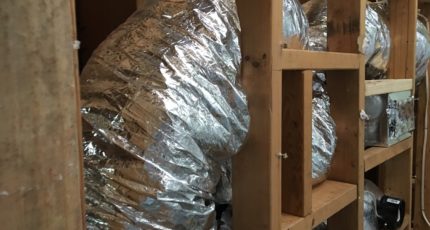
A seemingly perfectly maintained house can develop mold problems without immediate detection due to problems in an HVAC system. If the system was not properly installed or it is improperly operated, ripe conditions can create moisture in the HVAC that allows mold to lurk and grow.
For this reason, Green Star Eco Services likes to accompany HVAC companies on seasonal tune-up jobs and other home visits to inspect for mold in A/C ductwork, the plenum, supply boxes and other surrounding areas, such as ceilings and attics.
We have seen how easily a loose fitting in a system can cause condensation to form, which invites mold.
“The big reason we see mold develop is HVAC leakage. They’ll leak cold air into a hot attic, which creates condensation,” Marc Patel, owner of Green Star Eco Services said. “Once the condensation starts, the air that usually comes in from outside has Cladosporium and other outside molds in it.”
Then, the mold starts growing on both the outside of the HVAC and inside of the system.
A/C Overkill Can Create Too Much Humidity
Another reason an HVAC can harbor mold is if it is improperly balanced and generating too much humidity. Or, people can be running them incorrectly. If the A/C is set too low and the fan is set to On, then the system can never catch up with the amount of condensation it’s generating.
“It raises the humidity in the house. You should always run your fan on Auto,” Patel said. “If your system is set up properly and working properly, you really don’t need it turned down all that low. It should be dehumidifying properly. A 75 or 76-degree temperature inside the house should feel comfortable. If you have to run it at 70 or below, you might want to check to see if it’s dehumidifying properly.”
An HVAC company will check to see if a system is running optimally, whether it is properly zoned, if the internal operation of the unit is clean and efficient, etc. When going in with a licensed HVAC company on a routine check or other system check, Green Star Eco can see parts of the HVAC system that is normally not easily accessible and inspect it for mold.
When to Clean, When to Replace
Some equipment and materials can be cleaned. Others should be replaced if moldy. For example, the plenum, or air box on the supply side, can sometime leak, leading to mold inside. In some cases, this can be cleaned, but other times it is better to replace it. Likewise, flexible ducting is not easily cleaned and if mold-ridden, should be replaced with new duct work material.
“Sometimes the mold is localized and it’s right where it’s leaking at the connections and we can reach in and clean that,” Patel said. Similarly, Green Star Eco Services can reach in to clean the supply boxes behind the vents, the vents themselves and into ductwork if it is a localized issue.
Improved Antimicrobial Technologies
In addition to ensuring an HVAC system is running properly, there are system enhancements. One is an ozone generator called REME HALO that is installed in the plenum to inhibit growth of microbes and mold in the duct work. “That can keep those areas continuously clean, even if we can’t get into them. There are several different things you can do with an HVAC system maintenance to prevent mold,” Patel said.
